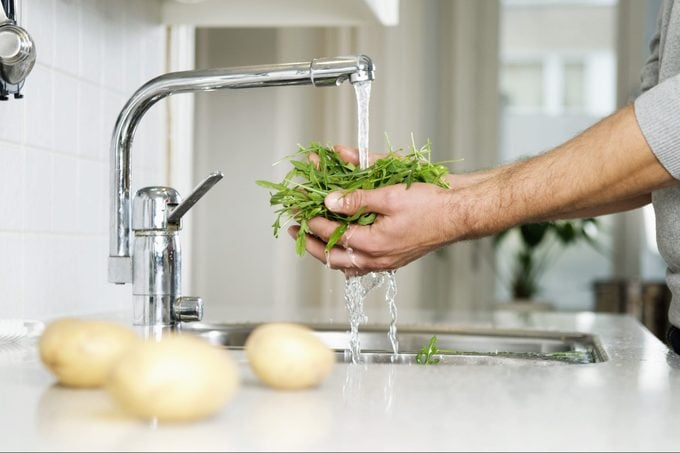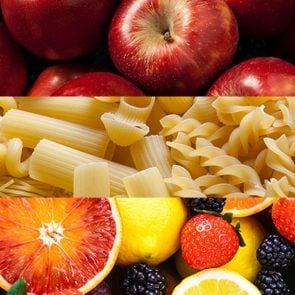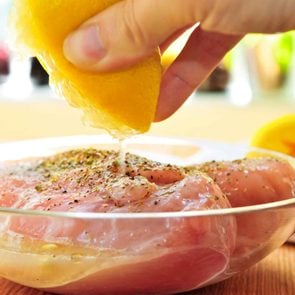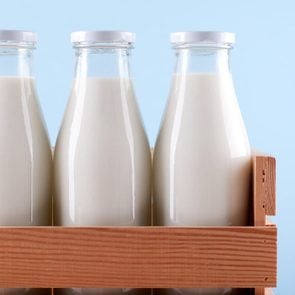How to Wash Lettuce Correctly (and Dry It)
Updated: May 28, 2021
Here's the ultimate guide to preparing lettuce for maximum food safety. (Plus whether or not you need to give prewashed lettuce an extra rinse.)
Eat your greens
You know why you need to eat your greens, but washing them? That you may be a little less clear on. How carefully do you need to rinse lettuce? And exactly how clean are those prewashed bags of spinach and other greens?
We get it: it’s confusing. But knowing how to wash lettuce is important for food safety.
Just as meat and poultry can contain pathogens that can make you sick, fruits and vegetables can be a source of foodborne illness. Washing greens before eating is a way to keep yourself safe.
Keep reading for tips on how to wash lettuce correctly, plus other best practices.
The importance of washing produce in general
Harmful microbes can contaminate produce at several stages of the food production process, including when they’re in the soil or once they are packaged and stored, according to research in the journals Applied and Environmental Microbiology and Food Microbiology.
You may even have a higher risk of getting sick from contaminated produce, including lettuce and leafy greens, because they aren’t cooked like other foods.
In fact, half of the reports of foodborne diseases—both in the United States and globally—tie to produce, says Sanja Ilic, a food safety specialist and nutrition professor at The Ohio State University.
In 2019 and 2020 alone, three multi-state food-poisoning outbreaks (including for E. coli and salmonella) were associated with leafy greens, according to the Centers for Disease Control and Prevention (CDC).
People who have a higher risk of getting food poisoning, including the elderly, young children, people with weakened immune systems, and pregnant women, need to be especially diligent about consuming well-washed produce, according to research in Foodborne Pathogens and Disease.
Why the extra risk with foods we typically associate with health benefits? Cooking can kill pathogens, and people typically eat greens raw.
So washing fruits and vegetables is an important first line of defense against foodborne illnesses.
How clean is prewashed lettuce?
Let’s face it, eating enough vegetables is hard. Taking the extra step to wash and clean them thoroughly can be another barrier to getting greens in your diet.
Food companies have tried to make our lives a little easier by prewashing lettuce. The idea is that we can simply toss the greens in a bowl, add some toppings, pour over a bit of salad dressing, and have a quick and nutritious salad ready in minutes.
The Food and Drug Administration (FDA) says that prewashed leafy greens do not have to be washed at home, Ilic says.
But is prewashed lettuce really clean? This depends on your definition, of course.
According to research in the journal Food Microbiology, the effectiveness of prewashing lettuce on bacterial loads depends on the type of greens and the number of bacteria present before washing.
When researchers at the University of California Riverside studied prewashed spinach leaves, they discovered that the leaf’s makeup affected contamination. Reporting in the journal Food Microbiology, they said that crevices in spinach leaves may reduce the ability of sanitizing solutions to access the entire leaf surface, thus potentially reducing the effectiveness of cleaning.
Another study, published in the International Journal of Food Microbiology, found the effectiveness of prewash also has to do with the cleaning agent.
But keep in mind that prewashing isn’t the only consideration when it comes to the food safety of packaged lettuce. Research at the USDA Agricultural Research Service suggests that storage temperature impacts bacterial growth within packaged lettuce containers.
What’s the point of prewashing?
In expecting our prewashed greens to be bacteria free, we may be missing the point.
Karl Matthews, a food science department chair at Rutgers University, says commercial lettuce cleaning is meant to wash the produce of any soil or debris, not specifically get rid of bacteria on the produce itself.
A mix of sanitizer and water for washing exists. Still, it’s used to limit the potential for cross-contamination from bacteria that may exist in the water itself, Matthews says.
Ilic agrees.
“Producers do not wash lettuce to eliminate pathogens,” she says. “However, proper washing will eliminate mass contamination of the product.”

OK, but are the cleaning agents safe?
While people rinse veggies in tap water, sanitizing solutions—bleach, chlorine, modified water, or other harsh disinfecting agents—may help remove bacteria from the leaves. That’s what the studies published in Food Microbiology and the International Journal of Food Microbiology found.
If you’re worried about eating greens that have been washed in chemicals, don’t be. Chlorine is a common lettuce sanitizer, and both Ilic and Matthews say there’s generally no harm in this practice.
“If it is properly used, there are no health consequences,” Ilic says.
Water is monitored during washing to determine residual chlorine levels, Matthews says. There is typically no more chlorine left on a leaf than we may find in drinking water.
So while it may seem the verdict is still out on the cleanliness of prewashed lettuce, consider that the sanitizer may do a better job reducing bacterial load than the tap water we use at home.
Matthews adds there is always a risk to produce consumption, whether prewashed or not. But the industry is working to mitigate these risks.
(Should you still be disinfecting your groceries from Covid-19?)
Should you wash your lettuce at home?
The answer to that depends on the type of greens you’ve purchased. Namely, have they been prewashed?
All things considered, it may not be worth it to wash your prewashed greens. Doing so isn’t likely to further reduce potential exposure to bacteria.
In fact, there’s a good chance that bacteria that survived the chemical washing process will also survive your at-home rinsing with tap water.
As we said, the Food and Drug Administration (FDA) says you don’t have to rinse prewashed leafy greens, and exposing it to water may cause it to spoil more quickly.
“Refraining from washing pre-bagged produce will prevent excess water from contacting the product, which may lead to accelerated spoilage and pathogen growth,” Ilic says.
If you decide to forego prewashed lettuce—say, if you get your greens from local farmers market—Ilic recommends washing them at home.
And try to eat the greens as close to the purchase date as possible and shortly after washing at home. This will limit the amount of time bacteria can grow, research in the Italian Journal of Food Safety suggests.
And while it can be tempting to pre-cut lettuce in an attempt to make meal prep easier, resist that urge. Normal bacteria can grow on the cut surface of leaves, Matthews says, and intact lettuce will likely last longer.
He suggests storing lettuce away from products that can cause contamination, such as meat, poultry, and fish.
How to wash lettuce
If you’re not sold on prewashed lettuce and are looking to buy unwashed lettuce from a market or store, here are some simple steps you can take to ensure that you are doing it correctly.
First off, keep in mind that no washing method will completely eliminate all the microorganisms found on our food, so the goal here is to do your best to practice safe food handling.
1. Wash your hands.
Start by washing your hands for at least 20 seconds with soap and water before (and after) handling your greens or produce, according to the FDA.
2. Discard bad leaves.
Get rid of any bruised or torn leaves that may already be bad. These can serve as pathways for bacteria to populate on the food, according to research in the journal Food Microbiology.
3. Discard the outer leaves.
The outer leaves of greens may be more susceptible to contamination than the inner leaves, due to their direct contact with the environment and food handlers. You can also discard them to prevent more exposure to harmful bacteria.
4. Wash the lettuce.
Run the greens under water. The CDC also recommends using your hands to wipe the leaves to help get rid of soil or organic debris.
Neither the FDA nor the CDC recommend using soap, detergent, bleach solutions, produce washes, or disinfectant to wash your produce. Stick with plain old tap water, a recommendation Ilic and Matthews reinforce.
You can also try adding some vinegar or lemon juice into a water solution, but according to the CDC, there is no evidence that this helps remove bacteria better than tap water.
5. Dry the lettuce.
After rinsing your lettuce, simply dry it on a clean cloth or paper towel. You can use a salad spinner first or after drying on the absorbent surface. Just make sure it’s clean.
More tips for preparing produce
Here are a few other best practices to keep in mind when washing and drying your lettuce:
- Avoid soaking your greens in a bowl or sink filled with water. This allows contamination to spread from leaf to leaf, further contaminating the entire package. And if your sink isn’t clean, you could be adding contaminants where there previously was none.
- Use filtered, bottled, or distilled water for rinsing if you don’t have access to safe tap water. That’ll prevent excess bacteria from contaminated water from getting on your veggies.
- Choose greens that are fresh and not damaged or bruised, as bruising can increase the potential for bacteria to enter your food
- Make sure you refrigerate your greens within one to two hours of buying them. They should be kept at a temperature below 40° F; bacteria grow rapidly in temperatures between 40° and 140° F.
- Finally, practice safe food handling when dealing with foods like meat. Use separate cutting boards for meat and vegetables, and make sure you cook thoroughly or throw out any vegetables that have been exposed to raw meat, fish, and poultry. This will help you limit the potential for cross-contamination.
Leafy greens are an essential part of a healthy diet, and most Americans don’t get enough. Knowing how to wash and dry lettuce to prevent food poisoning can help more people feel comfortable eating greens and getting enough of the key nutrients they provide.
Next, check out how to wash pesticides off of fruit.

 11 Food Storage Tips" width="295" height="295" />
11 Food Storage Tips" width="295" height="295" />
